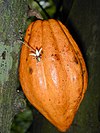Dutch process cocoa
 Dutch process cocoa (left) compared to natural cocoa (right) | |
| Alternative names | Dutched cocoa |
|---|---|
| Type | Cocoa |
| Place of origin | Netherlands |
| Created by | Coenraad Johannes van Houten |
| Main ingredients | Cocoa powder, alkalizing agent |
Dutch process cocoa or Dutched cocoa[1] is cocoa solids that have been treated with an alkalizing agent to reduce the natural acidity of cocoa, giving it a less bitter taste (and darker colour) compared to "natural cocoa" extracted with the Broma process.[1] It forms the basis for much of modern chocolate, and is used in ice cream, hot chocolate, and baking.
Alkalizing agents employed vary, but include potassium carbonate or sodium carbonate.
Dutching greatly reduces the levels of flavonoids in cocoa. However, since cocoa has very high levels, even Dutched cocoa still has high levels.
History[]
The Dutch process was developed in the early 19th century by Dutch chocolate maker Coenraad Johannes van Houten, whose father Casparus was responsible for the development of the method of removing fat from cocoa beans by hydraulic press around 1828, forming the basis for cocoa powder. These developments greatly expanded the use of cocoa, which had been mostly used as a beverage in Europe until that time.[citation needed]
Taste and cooking properties[]
Dutch processed cocoa has a neutral pH, and is not acidic like natural cocoa, so in recipes that use sodium bicarbonate (baking soda) as the leavening agent (which relies on the acidity of the cocoa to activate it), an acid must be added to the recipe, such as cream of tartar or the use of buttermilk instead of fresh milk. There is no need to add acidity when Dutch process cocoa is used in recipes that use baking powder instead of soda for leavening.[2]
Reduction of antioxidants and flavonols[]
Compared to other processes, Dutch process cocoa contains lower amounts of flavonols (antioxidants).[3] The effect this has on nutritional value is disputed. Professor Irmgard Bitsch of the Institut für Ernährungswissenschaft, Justus-Liebig-University Giessen claims that the reduction of antioxidants due to the process is not significant and enough polyphenols and procyanidins remain in the cocoa.[4] One study determined that 60% of natural cocoa's original antioxidants were destroyed by light dutching and 90% were destroyed by heavy dutching.[5] However, natural cocoa has such high levels of antioxidants that even a 60% reduction leaves it high on the list of antioxidant-rich foods.[6]
References[]
- ^ Jump up to: a b "Art of Darkness II: Cocoa : Good Eats". Food Network. 2009-11-16. Archived from the original on 2008-09-17. Retrieved 2013-05-27.
- ^ "Cocoa Powder". Joyofbaking.com. Retrieved 2013-05-27.
- ^ "Chocolate Terms". Thenibble.com. Retrieved 2013-05-27.
- ^ "Kakao und Schokolade: Die geheimen Gesundmacher". medizinauskunft.de. Retrieved 2016-10-01.
- ^ "New study re-emphasizes natural cocoa powder has high antioxidant content". Eurekalert.org. 2008-10-08. Retrieved 2013-05-27.
- ^ Crozier, S. J.; Preston, A. G.; Hurst, J. W.; Payne, M. J.; Mann, J.; Hainly, L.; Miller, D. L. (2011). "Cacao seeds are a "Super Fruit": A comparative analysis of various fruit powders and products". Chemistry Central Journal. Chem Cent J. 2011; 5: 5. 5: 5. doi:10.1186/1752-153X-5-5. PMC 3038885. PMID 21299842.
- Dutch chocolate
- Chocolate industry
- Dutch cuisine
- Dutch inventions
- Industrial history of the Netherlands
- Food powders






